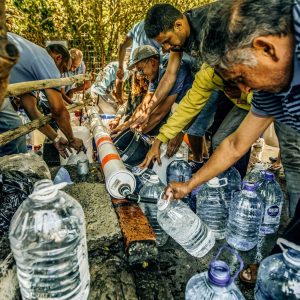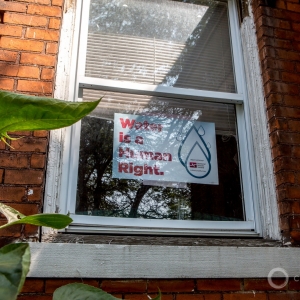Federal Water Tap, February 17: Planet’s Hottest January Ever Measured, NOAA Finds
The Rundown
Water legislation introduced in Congress targets microplastic pollution, faulty septic systems, and buckled canals in California. The GAO recommends incorporating climate change planning into federally funded drinking water and sewer projects. The National Weather Service signals higher than normal flood risk this spring for the eastern Missouri River basin. Federal agencies are scheduled to release, by the end of the month, a review of dam operations in the Columbia River basin. And lastly, last month was the hottest January on record.
“But what you have is, when that gets painted black, it becomes virtually untouchable during many parts of the season because of the sun hitting it. The black absorbs the heat. So not only would you have to be a good climber, but you’re going to have to bring a hose with lots of water to water it down, and there aren’t too many hoses in the area, and there’s not too much water in the area either.” — President Donald Trump speaking about his wall on the Mexican border, in an address to members of the National Border Patrol Council.
By the Numbers
60.9 million acre-feet: Missouri River runoff in calendar year 2019, the second-highest on record behind 2011. The current forecast for this year is 36.3 million acre-feet. (Army Corps)
#1: The global average temperature in January was the hottest ever measured. Records date to 1880. At 2.05 degrees Fahrenheit above the long-term average, the monthly temperature differential — meaning the measured temperature minus the average — was the fourth-largest of any month. (NOAA)
News Briefs
Water Bills in Congress
- Rep. Brian Mast (R-FL) introduced a bill that would have the U.S. Environmental Protection Agency establish a pilot program for removing microplastics that are already in the environment and preventing future pollution. Projects eligible for the grants would be located within stormwater control systems, wastewater treatment plants, drinking water treatment plants, and within waterways, ports, and harbors.
In context: ‘It’s Raining Plastic’: Researchers Find Microscopic Fibers in Colorado Rain Samples
- Bills introduced in the House and Senate would direct the EPA to establish a grant program to repair or replace septic tanks for low-income households. The bill also allows grant funds to pay for waste treatment systems that serve a cluster of homes. The bill is sponsored by Sen. Cory Booker (D-NJ), Shelley Moore Capito (R-WV) and Doug Jones (D-AL) and Rep. Terri Sewell (D-AL).
In context: Septic Infrastructure in the United States
- Representatives from California’s Central Valley introduced legislation that would provide $400 million in federal funding to repair two water delivery canals that have been damaged by land subsidence. The canals, which use gravity to move water to farms and cities, are being operated at less than full capacity. “We need to invest in our water infrastructure now for the future sustainability of our State and the livelihood of our residents,” Rep. Jim Costa (D-CA), the bill sponsor, said last week on the House floor.
In context: Sinking Land Causes California Water Chokepoint
Studies and Reports
Water Infrastructure and Climate Change
Congress should consider requiring recipients of federal water infrastructure funding to account for climate change in their designs, according to a Government Accountability Office report.The GAO examined ways to improve climate resilience for drinking water and sewer infrastructure projects.
In addition to requiring climate planning, the watchdog group suggested that the EPA expand its technical assistance to water utilities, which may not have the expertise to evaluate climate risks in their service areas.
The report was based on interviews with officials at four federal agencies, 15 water utilities, and 10 outside experts.
On the Radar
Missouri River Flood Risk
Spring flood risk is significantly higher than normal in the eastern half of the Missouri River basin, according to a National Weather Service seasonal forecast.The basin’s eastern half includes eastern Dakotas, eastern Nebraska, western Iowa, eastern Kansas and most of Missouri. Severe flooding devastated the basin last year. Water moisture maps show that soils and shallow groundwater in the northern Plains are highly saturated.
Columbia River Environmental Review
By the end of the month, federal agencies in the Pacific Northwest are scheduled to release the draft environmental review of dam operations in the Columbia River basin.Ordered by a federal judge, the review will assess how the dams influence the basin’s endangered salmon and other species. One option that the review will evaluate is breaching four dams on the lower Snake River, a major tributary.
Federal Water Tap is a weekly digest spotting trends in U.S. government water policy. To get more water news, follow Circle of Blue on Twitter and sign up for our newsletter.
Brett writes about agriculture, energy, infrastructure, and the politics and economics of water in the United States. He also writes the Federal Water Tap, Circle of Blue’s weekly digest of U.S. government water news. He is the winner of two Society of Environmental Journalists reporting awards, one of the top honors in American environmental journalism: first place for explanatory reporting for a series on septic system pollution in the United States(2016) and third place for beat reporting in a small market (2014). He received the Sierra Club’s Distinguished Service Award in 2018. Brett lives in Seattle, where he hikes the mountains and bakes pies. Contact Brett Walton






Leave a Reply
Want to join the discussion?Feel free to contribute!